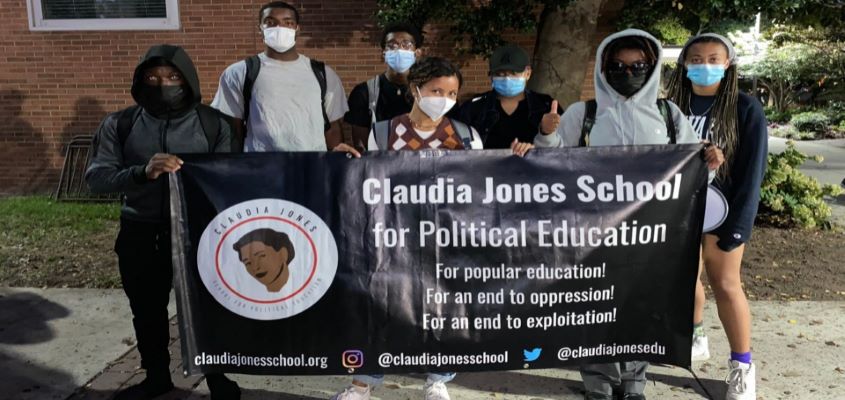
Students at Howard University have historically been in the forefront of movement struggles.
Now they are protesting tuition hikes, student loan debt, a lack of accountability, and all the hallmarks of the neo-liberal university.
On late Tuesday, Oct. 12, Howard University students began staging a sit-in demonstration at the Blackburn building in front of the historic Yard. Students brought sleeping bags and food and began demonstrating and making demands that the university protect their health on campus.
In the past month, as students returned to the school after more than a year under COVID conditions, a Twitter video went viral showing a puddle of water filling the floor of a kitchen in a dorm room. Later reports confirmed pooling water in students’ closets and bedrooms as well.
The university responded to the apparent lack of maintenance and upkeep, saying, “There have been rooms in select residence halls that were affected by mold growth.” There are already reports about students that have been hospitalized after becoming ill and coughing up blood.
Led by The Live Movement , the students sitting in are demanding:
- An in-person town hall with Howard University President Frederick and the administration before the end of October.
- Reinstatement of all affiliate trustee positions (students, faculty, and alumni) on the board of trustees with voting power.
- That the president and chairman of the board propose a meeting with student leadership outlining their “housing plan” to protect the incoming classes of Howard’s immediate future.
Other organizations, which count Howard students among their members, are showing their support in the fight for better housing conditions on the campus. They include the DC abolitionist organization Harriet’s Wildest Dreams, Freedom Fighters DC, and the Claudia Jones School for Political Education’s Howard youth affiliate, the Claudia Jones Club.
The student organizers had invited the administration officials to a town hall on Tuesday night to address their demands, but the university responded by sending the police and forcibly removing the students from the Blackburn building. As of Wednesday, students were no longer able to enter the Blackburn building, so the protest continued on The Yard and the areas surrounding the building.
So what is the Board of Trustees, and why are the Howard students protesting it? The Board of Trustees is the governing body of the university. It oversees tuition costs, budgeting, and a host of other activities related to the functioning of the school. Although the members of the Board of Trustees present themselves as representing the interests of the university, they are an unelected group of wealthy individuals who are not accountable to the students, faculty, or university staff.
“We need a unified and militant student movement if we’re going to present a serious challenge to private interests running our university,” second-year Howard University student Aaron Booe told People’s World.
Booe is a member of the Claudia Jones Club , which says the Board of Trustees has failed the students. The university claims that 94% of the student body is housed, but many students are currently dealing with incredibly unsafe living conditions that threaten their health and safety. The club says it’s involved in the protests because all students deserve safe and accessible housing.
In a leaflet distributed to students, the Claudia Jones Club summarized the situation:
“Since 2008, the cost of tuition has nearly doubled while the median household income of working Black families has only decreased. The university has already shown it’s capable of providing relief. The students need a tuition cap and a transparent tuition calculation process that democratically involved students.
“The decision to remove student, faculty, and alumni from the Board was not a mistake, it was an intentional act to silence the voices of poor and working-class Black people. Howard students need a democratic organization that not only listens to students but actively defends their class interests.”
The current fight for safe housing is eerily like the Occupy protests of 2011 and 2012 at University of California campuses in which students staged sit-ins at UC Regent offices to protest tuition hikes. Those demonstrations led to many arrests, one of which was captured in a viral video showing students being pepper sprayed at point-blank range at UC Davis.
Tuition inflation remains a crisis today, as the student debt load inches its way toward $1.9 trillion in the United States, with a majority of the holders being Black women––a central problem for a historically Black college like Howard University.
There is also a long history of struggle at Howard, including the most recent protests and occupations that happened in 2018 .
This militant energy coming during a return to school that’s happening in the middle of a pandemic shows the contradictions of U.S. society which affect everybody. Hopefully, the current fightback can help spark a mass student movement that will spread to other campuses and demand better policies, more democracy, abolition of tuition fees and debts, and a less stressful environment for students and workers.
 RSS Feed
RSS Feed















 October 23rd, 2021
October 23rd, 2021  Awake Goy
Awake Goy  Posted in
Posted in  Tags:
Tags: 













